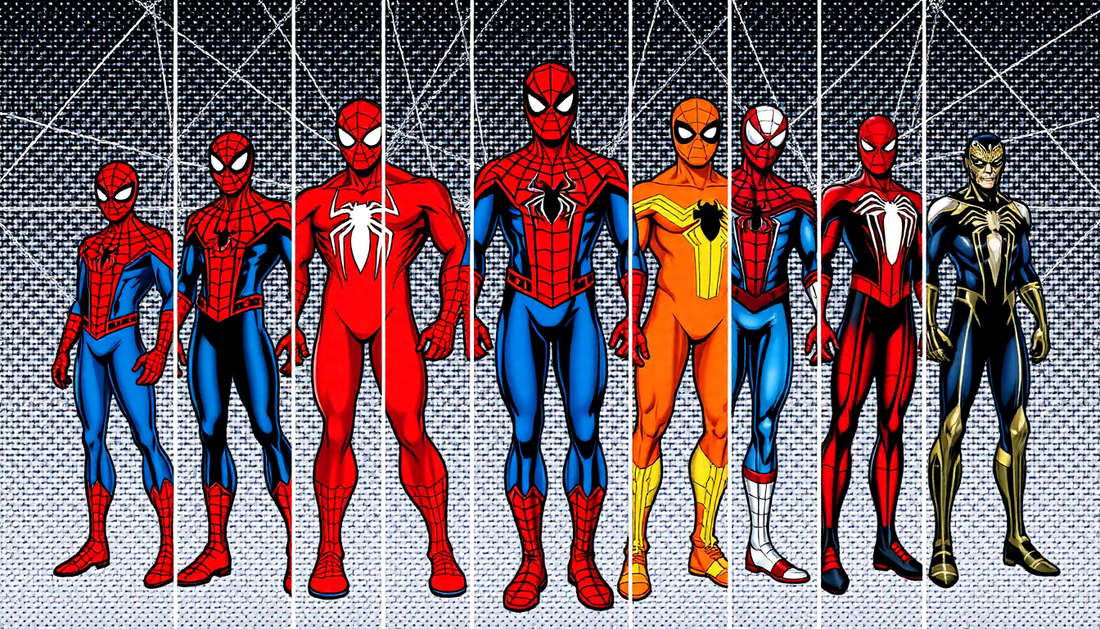
The Evolution of the Spider-Man Suit: From Classic to the Multiverse
Spider-Man, one of the most iconic superheroes of all time, has captivated audiences for decades with his thrilling adventures and unique abilities. At the heart of this beloved character is his iconic suit, which has undergone a remarkable evolution over the years, reflecting the changing times and the creative vision of the artists and writers who have brought him to life.
The Classic Spider-Man Suit
The original Spider-Man suit, designed by artist Steve Ditko, made its debut in 1962 in the pages of Marvel Comics' "Amazing Fantasy" #15. This classic design, with its vibrant red and blue color scheme, web-patterned fabric, and distinctive spider emblem on the chest, has become a timeless symbol of the character. The suit's simplicity and elegance captured the essence of Spider-Man's powers, blending his agility, strength, and web-slinging abilities into a visually striking costume.
The classic Spider-Man suit was more than just a fashion statement; it was a reflection of the character's humble beginnings. Peter Parker, a socially awkward high school student, transformed into the web-slinging hero through a twist of fate, and his homemade suit embodied his scrappy, resourceful nature. The suit's utilitarian design, with its practical web-shooters and mask that concealed his identity, allowed Spider-Man to navigate the urban landscape of New York City, fighting crime and protecting the innocent.
The Symbiote Suit
As Spider-Man's popularity grew, so too did the desire to explore new creative directions for the character. In the mid-1980s, the introduction of the symbiote suit, later revealed to be the alien symbiote Venom, marked a significant shift in the evolution of the Spider-Man costume.
The symbiote suit, with its sleek black design and ability to morph and adapt to its wearer's needs, represented a darker, more powerful side of Spider-Man. The suit's ability to enhance the hero's abilities, while also exerting a subtle influence over his mind, added a layer of complexity to the character's journey. The symbiote suit's introduction not only provided a visually striking new look for Spider-Man but also explored the themes of temptation, control, and the consequences of power.
The symbiote suit's impact on the Spider-Man mythos was profound, leading to the creation of one of the character's most iconic and formidable foes, Venom. The symbiote's separation from Spider-Man and its bonding with Eddie Brock, a reporter harboring a deep resentment towards the web-slinger, gave birth to a new villain that would go on to become a fan-favorite and a staple of the Spider-Man universe.
The Technological Advancements
As the decades passed, Spider-Man's suit continued to evolve, reflecting the technological advancements of the modern era. The introduction of the Iron Spider suit, designed by Tony Stark, showcased the integration of cutting-edge technology into the classic Spider-Man design.
The Iron Spider suit, with its sleek metallic accents, retractable spider-legs, and advanced capabilities, represented a significant departure from the homemade aesthetic of the original suit. This technological upgrade not only enhanced Spider-Man's abilities but also highlighted the character's growing role in the larger Marvel Cinematic Universe, where he collaborated with other heroes and utilized state-of-the-art equipment.
The technological advancements in Spider-Man's suit also extended to the web-shooters, which evolved from the simple mechanical devices of the past to more sophisticated, computerized systems. These upgrades allowed Spider-Man to access a wider range of web-based abilities, from tracking and targeting enemies to deploying specialized web-based gadgets.
The Multiverse Influence
The advent of the Marvel Multiverse has further expanded the creative possibilities for Spider-Man's suit, introducing a diverse array of alternate versions and designs that have captivated fans worldwide.
The Spider-Verse storyline, which explored the vast multiverse of Spider-Man variants, showcased a dazzling array of unique suits, each reflecting the distinct personalities and backgrounds of the different Spider-Heroes. From the futuristic Spider-Man 2099 suit to the punk-inspired Spider-Gwen costume, these multiverse-inspired designs have added a new level of visual diversity and storytelling potential to the Spider-Man mythos.
The multiverse has also allowed for the exploration of alternate timelines and realities, where Spider-Man's suit has taken on unexpected forms. The Spider-Man: Into the Spider-Verse film, for example, introduced the vibrant, animated style of the Miles Morales Spider-Man suit, which blended classic elements with a fresh, contemporary aesthetic.
The Enduring Legacy
The evolution of the Spider-Man suit, from its humble beginnings to its current multiverse-spanning designs, is a testament to the enduring popularity and creative versatility of the character. Each iteration of the suit has reflected the changing times, the artistic vision of the creators, and the thematic exploration of Spider-Man's journey.
Whether it's the classic red and blue, the sleek black symbiote, the technologically advanced Iron Spider, or the diverse multiverse variants, the Spider-Man suit has become an iconic symbol that transcends the boundaries of comics and film. It is a visual representation of the character's core values, his struggles, and his unwavering commitment to protecting the innocent.
As Spider-Man continues to captivate audiences and inspire new generations of fans, the evolution of his suit will undoubtedly continue, reflecting the ever-changing landscape of popular culture and the boundless creativity of the artists and writers who bring this beloved hero to life.


